Pennsylvania Railroad class S1
| Pennsylvania Railroad S1 | |||||||||||||||||||||||||||||||||||||||||||||||||||||||||
|---|---|---|---|---|---|---|---|---|---|---|---|---|---|---|---|---|---|---|---|---|---|---|---|---|---|---|---|---|---|---|---|---|---|---|---|---|---|---|---|---|---|---|---|---|---|---|---|---|---|---|---|---|---|---|---|---|---|
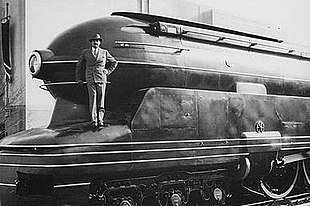 Industrial designer Raymond Loewy stands on the front of the S1 | |||||||||||||||||||||||||||||||||||||||||||||||||||||||||
| |||||||||||||||||||||||||||||||||||||||||||||||||||||||||
| |||||||||||||||||||||||||||||||||||||||||||||||||||||||||
| |||||||||||||||||||||||||||||||||||||||||||||||||||||||||
| |||||||||||||||||||||||||||||||||||||||||||||||||||||||||
The PRR S1 class steam locomotive (nicknamed "The Big Engine") was a single experimental locomotive, the longest and heaviest rigid frame reciprocating steam locomotive ever built.[1] The streamlined Art Deco styled shell of the locomotive was designed by Raymond Loewy.[1][2]
The S1 was the only locomotive ever built with a 6-4-4-6 wheel arrangement. It was a duplex locomotive, meaning that it had two pairs of cylinders, each driving two pairs of driving wheels. Unlike similar-looking articulated locomotive designs, the driven wheelbase of the S1 was rigid. In order to achieve stability at fast passenger train speeds (above 100 mph), articulation was not used. The S1 was completed January 31, 1939 and was numbered 6100.
At 140 ft 2 1⁄2 in (42.74 m) overall, engine and tender, the S1 was the longest reciprocating steam locomotive ever; it also had the heaviest tender ( 451,840lb/205 tonnes ), highest tractive effort (76,403 lbf (339.86 kN)) of a passenger steam engine when built and the largest drivers (84 inch diameter) ever used on a locomotive with more than three coupled axles. The problem of wheel slippage, along with a wheelbase which was too long for many of the rail line's curves, limited the S1's usefulness. No further S1 models were built as focus shifted to the much smaller but more practical class T1 in June 1940.
Construction and historical background
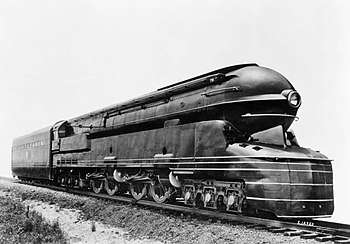
As early as June 1936, Pennsylvania Railroad officials decided to build a new passenger locomotive to replace its aging K4s locomotives. The PRR officials also hoped that the new S1 steam locomotive would have a performance equal to their GG1 electric locomotive and would be capable of hauling a 1,000-ton passenger train at 100 mph. [3] A conference was held between Baldwin Locomotive Works officials and W.F. Kiesel, J.V.B. Duer and W.R. Elsey for PRR, where PRR demanded a passenger locomotive to haul 15 standard cars at 100 mph on level track between Paoli and Chicago. Baldwin presented a number of 4-8-4 and 4-4-4-4 designs made for other railroads. However, PRR rejected the 4-8-4 design in favor of a rigid frame duplex. PRR also asked Baldwin to consider the wheel arrangement 4-4-6-4. A month later, F. W. Hankins requested Baldwin Locomotive Works to submit a design for a 4-8-4 engine capable of handling a 2,000 ton train between Colehour and Harsimus Cove.
Two months after the conference, Baldwin Locomotive Works officials presented four designs to PRR: a 4-4-4-4 passenger locomotive that could haul 1,200 tons but exceeded existing weight and clearance restrictions; a 4-4-4-6 passenger locomotive that could haul 1,200 tons but also exceeded limits; a 4-8-4 freight locomotive with the same weight on drivers as an M1a, which failed to meet the requirements for a 2,000 ton train; and an articulated 4-6-6-4. PRR preferred 4-4-4-4 and asked Baldwin to consider a passenger version with 80" drivers and a freight version with 72" drivers. However, the cooperation between PRR and Baldwin, which proceeded without signing any agreement or contract, for the development of the new high speed duplex engine was not going very smoothly. Ten months after the first conference, PRR ended Baldwin Locomotive Work's consultation and assigned the task to a consortium of Baldwin Locomotive Works, American Locomotive Company and Lima Locomotive Works under a joint contract. The members of the joint committee were Ralph P. Johnson, William Winterwood and H. Glaenzer of Baldwin, Dan Ennis of American Locomotive Company and William E. Woodard and Samuel Allen of Lima. It was headed by T. W. Demarest, General Superintendent of Motive Power in PRR's Western Region. [4]
On 28th April 1937, PRR's Board authorized $300,000 for this experimental high-speed passenger locomotive project. The design started with a 4-4-4-4 duplex.
On 2nd June 1937, PRR officially announced the development of the “Pennsylvania Type” high-speed passenger locomotive which would become Class S1. After various details were discussed and finalized, it became necessary to make changes that substantially increased the locomotive's weight. By the time the plans were finalized and approved it had evolved into a 6-4-4-6.[5]
Duplex Design
The reasoning for a duplex design was partly due to reducing hammer blows on the track, result in lower maintenance cost. Two sets of drivers with four wheels each could have lighter running gear than a locomotive with all four axles coupled together, smaller and lighter moving parts ensured less wear and tear. Also cylinder efficiency could be improved at high speed by getting the same power from four smaller cylinders with proportionately larger valves. Baldwin's chief engineer believed that the 8-coupled, 2 cylinder locomotives of the time were at or near practical limits in terms of steam flow as well. Using four cylinders was a way to get around that limitation. Theoretically such a locomotive would be more powerful and efficient than a conventional two cylinder design. Other advantages of duplex design include shorter cylinder stroke, lower piston speed for any given locomotive speed; lower piston thrust than a 4-8-4 at similar size. Using of rigid frame was considered far more stability at high speeds than articulated underframes and no hinged connection to maintain. [6]
Construction
The S1 was the largest passenger locomotive ever constructed, with an overall length of 140 feet 2 1⁄2 inches (42.74 m). At 77 feet (23.47 m) long and a weight of 97,600 pounds (44,300 kg; 44.3 t), the cast steel locomotive bed plate made by General Steel Castings was the largest single-piece casting ever made for a locomotive.[3][7] In order to negotiate sharper radius curves, S1 was equipped with Lateral motion devices made by Alco on its first and third set of drivers, allowing 57.2 mm (2.25 inches) of lateral play on the axles, but these proved to be inadequate. Unlike other experimental duplex engines like PRR's Class Q1 #6130 4-6-4-4, there were no flangeless wheels or blind drivers adopted on S1. In March 1938, C&NW's Class E4 4-6-4 "Hudson" #4003 was tested by PRR at Altoona.[8] Based on the test results, PRR decided to adopt 84" drivers and a cylinder pressure of 300 psi for the S1. PRR believed that the large diameter drivers could increase the tractive effort without causing undue slipping.[3] In August 1941, PRR VP-Western Region James M. Symes approved the extension of stall no. 30 of the Crestline roundhouse to accommodate the S1. The stall had a connection at the back, because the S1 could only be turned on a wye, but not on the roundhouse's turntable.
Timken roller bearings were equipped on the crosshead pins, all engine truck and driving axles as well as the tender trucks. In addition, the lightweight reciprocating parts were manufactured by Timken High Dynamic Steel and designed by Timken engineers. [9]
To get enough steel between the crank and axle, the back end of each main rod was offset 1 1⁄8 inches (29 mm) from the crank in the driver, so the big end made a 26-inch (660 mm) circle while each side rod pin made a 28 1⁄4-inch (718 mm) circle.
Massive Boiler and its Steaming Quality
The boiler for the S1 was the largest built by the Pennsylvania Railroad; with 660 square feet (61 m2) of direct heating surface and 500 one-inch diameter tubes and flues, the total heating surface area of S1 was 7,746 sq ft (719.6 m2), it was 99.3% as large as the boiler for Union Pacific's 4000-class 4-8-8-4 locomotive, the "Big Boy". In terms of drawbar horsepower, the S1 was 13% more powerful than the "Big Boy", 7200 hp and 6345 hp respectively. The large Belpaire firebox met the Pennsy's standards; its heating surface area included that supplied by seven American Arch circulators. Water passed through 5 1/2" horizontal tube met at the centerline with the other crosstube forming the bottom of the 7" vertical tube that sprayed the water up into the steam space above the crown sheet. The lowest set pair of tubes was forward with the side openings of the other six steadily rising toward the back. A large Worthington 6 SA feed water heater was fitted with a 7 SA pump to handle the enormous boiler's thirst. The six-wheel leading and trailing trucks were added, as the locomotive was too heavy for four-wheel units. The streamlined Art Deco styled shrouding of the locomotive was designed by Raymond Loewy,[1][2] a design concept based on his earlier streamlining design for PRR K4s #3768 in 1936, for which he received U.S. Patent No. 2,128,490.
Construction Costs and Test Runs
The cost of the S1 was $669,780.00, equal to $11,783,641 today.[3] which was over twice the cost of a PRR T1 4-4-4-4 (#6111 cost $310,676). No. 6100 was completed at Altoona on Dec.21, 1938 without streamlined casing. On the same day, it made its first road test with two cars. It ran backward to Huntingdon as there was no turntable large enough to turn it, then it returned to Altoona at speeds up to 50 mph. During the run, it was stopped and checked for overhang on all tight curves. Assistant Chief of Motive Power-Locomotive Carleton K. Steins (1891-1973) noted superior riding and steaming qualities. [10]
World's Fair Display
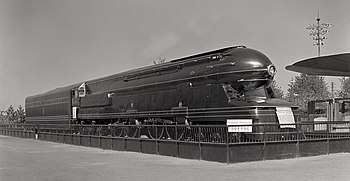
The S1 was displayed at the New York World's Fair of 1939-40 with the lettering "American Railroads" rather than "Pennsylvania Railroad", as 27 eastern railroads had one combined 17-acre (6.9 ha) exhibit, which also included the Baltimore & Ohio's duplex locomotive.[7] To reach the Fair the S1 took a circuitous route over the Long Island Rail Road. Many obstacles had to be temporarily removed and other obstacles were passed at a crawl to reach the fairgrounds.
On March 13, 1939, PRR S1 6-4-4-6 No. 6100, lettered “Americas Railroads” arrived at New York World’s Fair, having traveled over the Poughkeepsie and Hell Gate Bridge. At the Fair the drive wheels operated under the locomotive's own steam power.[3] This was done by placing the S1 on a platform that had rollers under the drive wheels. The drive wheels ran continuously on the roller platform at 60 mph (97 km/h) all day long during the Fair. Film footage shows that all the wheels on S1, besides the drive wheels, were also placed on rollers powered by electricity; every time S1 started its performance by moving the drive wheels, all the wheels were rolling, including the wheels on the tender's truck.
The New York World's Fair was open for two seasons, from April to October each year, and was officially closed on October 27, 1940. During the five-month break between October 1939 and April 1940, PRR S1 #6100 was put back on the system for passenger service and road testing. There is photo evidence showing that S1 was hauling the Manhattan Limited, a named train serving as an alternative to the Broadway Limited, in November 1939. [11]
Popular Mechanics described S1 as the "Pride of American Railroad" in an article in their June 1939 issue.[12] After the World's Fair the S1 was relettered and numbered for the Pennsylvania Railroad fleet. The S1 was used by the PRR for publicity purposes as well, and its image was featured in calendars, stamps, advertisements, brochures, puzzles etc. The American Bank Note Company issued a series of posters in 1939, published by the Eaton paper company as part of an advertising campaign. One of the posters depicts the S1 hauling the Broadway Limited.[13]
Service History
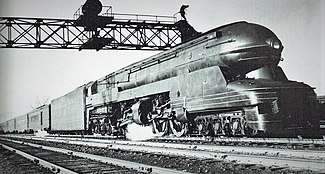
The S1 class locomotive was so large that it could not negotiate the track clearances on most of the lines of the PRR system. S1 began its passenger train services starting from December 1940, on the run between Chicago and Pittsburgh. On its first run out of Fort Wayne, Indiana, the crew was led by H.H. Lehman (Fireman), C.J. Wappes (Road Foreman) and Frank Ritcha (Engineer). Due to its gigantic size, S1 had to turn on Chicago, Burlington and Quincy Railroad's wye at Chicago before going eastbound and was unable to go through the 130 lb switch (No.8) just to the west of Pittsburgh Union Station [14] (This problem didn't get fixed until 1946 and also prevented the T1 operating through Pittsburgh). Therefore, in its brief service life it was restricted to the main line between Chicago, Illinois and Crestline, Ohio (283 miles/446 km). It was assigned to the Fort Wayne Division and based at the Crestline enginehouse.
Base on photographic evidences, S1 hauled the Broadway Limited in the first few months of her revenue service, but she contributed most of her career life to haul other much popular and commercially successful passenger trains such as The General , The Trail Blazer and The Golden Arrow on this route.[3] According to the PRR's roster on 26 November 1943, The consist of Train #77 The Trail Blazer had 14 rebuilt heavyweight passenger cars with streamlined features in total which including one PB70ER passenger baggage car, nine P70KR coaches, two D70CR and D70DR Diner, one P70GSR coach, and one POC70R coach-observation.[15] There are historical photographic and films evidence showing that S1 #6100 was the preferred engine of this popular, highly profitable (It carried 35 times more passengers than Broadway Limited in 1939, Gross Revenue equal to $2,260,000 in 1940 or $39,477,530 today.) and one of the longest and heaviest passenger train (more than 1000 tons) during the heyday of PRR's passenger services in early 40s.
Monthly mileage reports from the Hagley Library indicated that the S1 racked up 10,388-mile (16,718 km) or 20 round trips between Chicago, Illinois and Crestline, Ohio in Aug 1941 which was a very spectacular monthly mileage figure for a prototype, compared to K4s 6000 to 8000 miles monthly average mileage. This implied that the PRR had high regard for her ability, especially her power and speed. The S1 helped PRR to handle the extreme busy Wartime Traffic during WWII and paid off her high construction cost within one year. Crews liked the S1, partly because of its very smooth ride on speed. The great mass and inertia of the locomotive together with the unique, massive 6-wheel trailing truck which had independent suspensions and roller bearing equipped soaked up the bumps and the surging often experienced with duplex locomotives.
Starting tractive effort calculated in the usual way (85% mean effective pressure) comes out 76,400 lbf (340 kN), but the engine used 70% limited cutoff (presumably to increase port openings at short cutoff), so the railroad claimed a correspondingly lower tractive effort.
Operating Performance and Alleged speed records
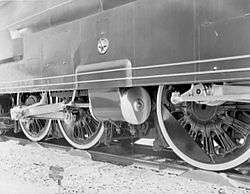
In terms of tractive effort and drawbar horsepower, PRR S1 was the most powerful reciprocating steam locomotive ever built for passenger service in 1939. During a test run between Chicago, Illinois and Crestline, Ohio in December 1940, S1 managed to reach 100.97 miles per hour (162.50 km/h) on level track with 1350 tons passenger stock behind her, which was equal to 24 postwar lightweight passenger cars.[16] During this test run, S1 also achieved an average speed of 66 miles per hour (106 km/h), which was 27% faster than the average schedule speed of the route. Some publishment from Germany stated that S1 was able to reach 120.01 miles per hour (193.14 km/h) in other road tests during late 1940s with lighter load behind her, but PRR never claimed this record. On Apr 19, 1941, during an excursion run organized by the Detroit Railroad Club, S1 reached 106 miles per hour (171 km/h) on the route between Fort Wayne and Chicago. [17]
An article "Riding the Gargantua of the Rails" [18] in the Dec 1941 Popular Mechanics Magazine cites a speed recorded by assistant road foreman Charlie Wappes of the Fort Wayne Division during the S1’s test runs at 133.4 miles per hour (214.7 km/h) with 12 heavyweight passenger cars in its back. There are other stories of the S1 reaching or exceeding 140 miles per hour (230 km/h). In the German trade press and literature from 1945, there was a report of a record run of the S1, citing railroad officials of Interstate Commerce Commission that a speed of 141.2 miles per hour (227.2 km/h) was reached when the engine was trying to make up time for a delayed westbound train, the Trail Blazer.[19]
Its high speed capability was such that many have claimed that the S1 exceeded on multiple occasions the 126 mph (203 km/h) record steam locomotive speed set in 1938 by the LNER locomotive Mallard. The locomotive was claimed to have exceeded 156 mph (251 km/h) on the Fort Wayne-Chicago run, as it was reported that the PRR received a fine for the feat.
Suspected Design flaws (no official record and sources provided)
For an experimental engine that had basked in the limelight, although it was designed and manufactured in collaboration by three largest locomotive manufacturers in America and operated by one of the largest railroad company in the world, her road records were unusually secretive. Any accusation about its performance without sources or documented evidence can only be seen as rumors and only can be used as reference.
The lack of curve compatibility led to the S1 not being used for its intended long distance express service, but it still managed to serve between Chicago and Crestline, Ohio which was 283 miles/446 km long for almost 5 and a half years, made it having the longest-serving record among all experimental steam engine prototypes of the PRR like Q1 4-6-4-4 and S2 turbine 6-8-6 during mid-40s.
Although the S1 had less than half (47%) its total weight on the driving wheels, but its Factor of adhesion was still very close to the much more successful PRR Q2, Santa Fe "Northern" 4-8-4 2900s and the renowned N&W Class J 4-8-4. More than half of its weight was being carried by the massive six-wheel pilot (leading) and trailing trucks with Timken roller bearing equipped. This left the two sets of four duplex driving wheels susceptible to wheel slippage, a dangerous condition for any steam locomotive, although during the 5 1/2 years service history of S1, no serious accident occurred or being recorded which was caused by wheel slippage.
If the powered wheels of a steam locomotive lose their adhesion to the rails and freely spin, the result is over speed damage. If the locomotive's engineer does not detect and rectify this situation at once two things will occur: first, the metal tires that surround the driving wheels will be seriously damaged; second, the piston rods, their bearings and the other equipment associated with the reciprocating motion of the engine will be damaged or destroyed. Wheel slippage causes a loss of friction between the wheels and the rails, which in turn allows the wheels and associated hardware to run excessively fast.
Normally, in a standard locomotive when starting under load from standing start, the engineer would observe the rearmost driving wheels and compare their movement to the movement of the locomotive over the ground. As locomotives grew larger, the engineer would listen to the rhythmic sound of the exhaust (the characteristic “chug-chug”) and compare the rhythm of this sound with the movement of the locomotive over the ground.
If, as they opened the engine’s throttle, the rate of increase of the “chug chug” sound was out of sync with the forward progress of the locomotive, they knew the wheels were slipping. A passenger locomotive with 72-inch-diameter (1,829 mm) drivers would travel nineteen feet (5.79 m) (over six yards or 5.49 meters) per “chug-chug”. It was therefore easy to correlate the rhythmic sound of the exhaust of a starting locomotive with the locomotive’s progress from a standing start. An engineer could thereby avoid applying too much power to a starting locomotive (by opening the steam throttle valve too much, and too quickly) and causing the wheels to slip.
The S1’s duplex engine design meant that two separate engines were concurrently and in sequence exhausting into two smoke adjoined stacks. This made it nearly impossible for a locomotive engineer to distinguish the behavior of an individual engine set, based upon the sound of its exhaust. Unless both sets of engines experienced wheel slip simultaneously, the sound of the normal set would mask the sound of the set that was slipping and over speeding. If the wheels began to slip, they would have no knowledge of this fact until the tires of the duplex engine’s wheels had already sustained damage, or they heard the crashing sounds of a duplex engine tearing itself apart in over speed.
The S1 was prone to wheel slippage. Unlike virtually all other steam locomotives that faced wheel slippage when starting, the S1 (because of the very light weight on the driving wheels) would experience engine wheel slip over the road at operating speed. The adhesion of the wheels to the rails was so light that even minor variations in the roadbed would cause either the forward or rearward duplex engines to slip. This hazard more than any other doomed the operating life of this engine. The loss of adhesion at speed (30–50 mph or 48–80 km/h and above) always did serious mechanical damage to the engine which lost adhesion, and to the locomotive as well.
Mitigation Measures
In order to increase the adhesion and improve performance, an extra massive sand dome was installed above the boiler by PRR, located between the first and second set of drivers. It ensured the supply of sand for steam sanding and slightly increased the axle load above the first and second set axle. S1 was partially de-skirted in 1942 to improve the visibility of the reciprocating parts for the crews and better operation.[20] Suspension springs of the pilot truck and trailer truck were fine-tuned to straighten out the overall weight distribution to achieve better performance. Railway Historian and Author Alvin F. Staufer agrees that she (S1) was oversized and thus unable to visit most roundhouses or handle tight curves, but contends: "She was an excellent steamer and gave trouble-free service." [21]
The design flaws of the S1 related to curve compatibility and wheel slip led to only one example being produced. Before S1 was officially put in revenue service, The PRR already ordered a shorter design that used four wheel lead and trailing trucks to place more weight on the drivers which was developed by Baldwin, the 4-4-4-4 T1 of 1942. Unlike the S1, the T1 was actually used for longer distance express service with such trains as the Broadway Limited and the Manhattan Limited, but the T1 was also plagued by wheel slip caused by reckless handling and mechanical failures of Franklin Type A rotary cam poppet valve gear. Unlike her duplexes sisters T1, PRR S1 didn't install any type of Poppet Valve Gear, even though it was proposed to install Franklin Type A rotary cam poppet valve gear during the middle of her construction in 1938, but such proposal was rejected due to technical difficulties. [22], this decision unexpectedly prevented a lot of troubles would have been caused during S1's service life. The total service years of S1 (from Nov 1939 to March 1940, Dec 1940 to May 1946) was ironically slightly longer than some of her younger T1s sisters (1946 to 1949 or 1947 to 1952).
Removal from service
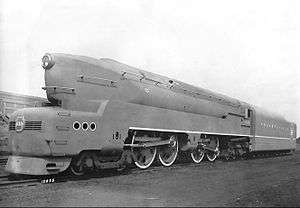
According to an official report from PRR dated December 1, 1945 which is now stored in The Hagley Museum and Library, S1 #6100 was awaiting engine truck repairs at Crestline. It was expected to be returned in service after a few days. This is one of a solid proof that S1 was still in service at least until December 1945. At the time, at least 13 T1 4-4-4-4 were already put into service.
A time-book belonging to Pennsy engineman Byron Breininger from the Ft. Wayne division records a trip to Chicago on S1 engine #6100 at 8:59 AM on May 5, 1946, this run was possibly one of its last in service. Less than two years later, PRR president Martin Clement announced that “By May of this year (1948) we expect all of our through passenger trains west of the electrified territory to be dieselized”[23]. Preservation of S1 was discussed inside PRR's board, but due to deteriorating financial situation since 1946, S1 #6100 was scrapped in 1949.[3][24] The PRR continued developing the T1 class of 4-4-4-4 duplex locomotives but this locomotive model also met with limited success.
Modern culture
The stylish appearance of the S1 has proven to be very popular:
- The S1 was represented in a 1939 painting by railroad artist Grif Teller that appeared in the Pennsylvania Railroad's picture calendar.
- The American Bank Note Company issued a series of posters published by the Eaton paper company as part of an advertising campaign in 1939, one of the posters depicts the S1 hauling the Broadway Limited
- CD Album "Night Train, Classic Railroad Songs, Volume 3" by Various Artists, Published by Rounder in 1998, a painting of S1 was used on the cover of the Album.
- CD Album "Black Diamond Express to Hell" by Various Artists, Published by Rev. A. W. Nix in 2006, features a perspective drawing of S1 which was used as the backbone of the cover's art design.
- In the PC game Gadget: Invention, Travel, & Adventure, one of the trains the player travels on is pulled by an S1 modeled locomotive.
- The Danish pop group 'Laid Back's third album 'Play It Straight', released in 1985, features a three-quarter view of the S1's bow on its cover, albeit in a gaudy pinkish red hue it never wore in service.
- The S1 appears in the Sandman comic series, book IX.
- In the anime The Galaxy Railways, the engine for Vega Platoon, Iron Burger, is loosely based on the S1, with the 4-8-8-4 wheel arrangement used for the Union Pacific Big Boy, which was used as the bases for Big One, the engine for Sirius Platoon.
- The S1 appears in the PC game Grim Fandango as "number nine"—the best vehicle for travel to the eternal rest.
- Solomon Island Stamps release a set of stamp in 2017 (Neofile #SI-17212a) with S1 and other express steam locomotive from all over the world like the LNER A4 Mallard on it, S1 was placed next to the LNER Mallard.[25]
See also
References
- 1 2 3 "Raymond Loewy-Locomotives". The Avanti. Archived from the original on 2007-09-27. Retrieved 2007-09-02.
- 1 2 "It's a bird! It's a plane! No, it's - an office tool". The Home Forum > Essays. The Christian Science Monitor. September 23, 2004. Retrieved 2007-09-04.
- 1 2 3 4 5 6 7 "Actual Production Models Shown". Brochures. www.lionel.com. 2003. Retrieved 2007-09-03.
- ↑ "PRR Chronology 1936" (PDF). PRR Chronology. Pennsylvania Technical and Historical Society. April 2015. Retrieved 2018-07-21.
- ↑ "PRR Chronology 1937" (PDF). PRR Chronology. Pennsylvania Technical and Historical Society. April 2015. Retrieved 2018-07-21.
- ↑ Pennsy Power by Alvin F. Staufer | 1962 | Page 217
- 1 2 Reed, Brian (June 1972). Pennsylvania Duplexii. Loco Profile 24. Windsor, Berkshire: Profile Publications Limited. pp. 267–271.
- ↑ "Black Gold - Black Diamonds: The Pennsylvania Railroad & Dieselization" Volume 1 by Eric Hirsimaki, July 1997, Page 85-86
- ↑ Waide Collection of Vintage Railroad Advertisements 1840-1949 https://waidephoto.smugmug.com/Trains/Waide-Collection-of-Vintage/i-NcMc82c/A
- ↑ "PRR Chronology 1937" (PDF). PRR Chronology. Pennsylvania Technical and Historical Society. April 2015. Retrieved 2018-07-21.
- ↑ Pennsy's “Big Engine” in the snow | Classic Trains Magazine | April 1st 2014 | http://ctr.trains.com/photo-of-the-day/2014/04/pennsys-big-engine-in-the-snow
- ↑ Popular Mechanics | Million-Pound Iron Horse is 140 Feet Long { https://archive.org/stream/PopularMechanics1939/Popular_Mechanics_06_1939#page/n109
- ↑ The Pennsylvania Railroad S-1 | http://www.jitterbuzz.com/stream.html#essone
- ↑ https://prrt1steamlocomotivetrust.org/faq.php | Question No.9 "Where it will run?"
- ↑ "Pennsy Streamliners: The Blue Ribbon Fleet by Joe Welsh, 1999, Page 54
- ↑ Dampflokomotiven in den USA 1825–1950 Band 2: Die technische Hochblüte der Dampftraktion 1921–1950, Page 112 | 1972 | Autoren: BUCHMANN
- ↑ Black Gold - Black Diamonds: The Pennsylvania Railroad & Dieselization" Volume 1 by Eric Hirsimaki, July 1997, Page 105
- ↑ http://streamlinermemories.info/PRR/Gargantua.pdf | Popular Mechanics Magazine | Dec 1941
- ↑ Rekord Lokomotiven, Die schnellsten der Schiene 1848-1950, P.134 | (1988) by Wilhelm Reuter
- ↑ Loco Profile, 24 : Pennsylvania DuplexII | 1972
- ↑ Pennsylvania "Duplex Drive" Locomotives in the USA, https://www.steamlocomotive.com/locobase.php?country=USA&wheel=Duplex&railroad=prr
- ↑ Loco Profile, 24 : Pennsylvania DuplexII | 1972
- ↑ Railway & Locomotive Historical Society Newsletter - Winter 2007
- ↑ "PRR Chronology 1945" (PDF). PRR Chronology. Pennsylvania Technical and Historical Society. April 2015. Retrieved 2016-02-20.
- ↑ SOLOMON ISLANDS STAMPS 2017 | http://www.neofila.com/stamps/world/solomon-islands.htm
| Wikimedia Commons has media related to Pennsylvania Railroad S1. |
